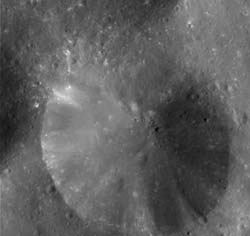Crater on Phoebe in close-up

Credits: NASA/JPL/Space Science Institute
This amazing high-resolution image of Phoebe’s pitted surface was taken very near the closest approach by the NASA/ESA/ASI Cassini-Huygens spacecraft.
It shows a crater with a diameter of 13 kilometres and a debris-covered floor. Part of another crater of similar size is visible at left, as is part of a larger crater at the top and many scattered smaller craters.
The radial streaks in the crater are due to downslope movements of loose fragments from impact ejecta (material thrown out by impacts). Also seen are boulders ranging from about 50 to 300 metres in diameter.
These ’building-sized’ rocks may have been excavated by large impacts, perhaps from some other region of Phoebe rather than the craters seen here. There is no visible evidence for layering of ice and regolith (or a hardened crust, or mantle) in this region, as on other parts of this moon.
Some of the relatively bright spots are from small impacts that excavated bright material from beneath the dark surface. Images like this provide information about impact and regolith processes on Phoebe.
The Cassini-Huygens mission is a co-operative project of NASA, ESA and the Italian Space Agency.
Media Contact
More Information:
http://www.esa.int/SPECIALS/Cassini-Huygens/SEMBZ33VQUD_0.htmlAll latest news from the category: Physics and Astronomy
This area deals with the fundamental laws and building blocks of nature and how they interact, the properties and the behavior of matter, and research into space and time and their structures.
innovations-report provides in-depth reports and articles on subjects such as astrophysics, laser technologies, nuclear, quantum, particle and solid-state physics, nanotechnologies, planetary research and findings (Mars, Venus) and developments related to the Hubble Telescope.
Newest articles

First-of-its-kind study uses remote sensing to monitor plastic debris in rivers and lakes
Remote sensing creates a cost-effective solution to monitoring plastic pollution. A first-of-its-kind study from researchers at the University of Minnesota Twin Cities shows how remote sensing can help monitor and…

Laser-based artificial neuron mimics nerve cell functions at lightning speed
With a processing speed a billion times faster than nature, chip-based laser neuron could help advance AI tasks such as pattern recognition and sequence prediction. Researchers have developed a laser-based…

Optimising the processing of plastic waste
Just one look in the yellow bin reveals a colourful jumble of different types of plastic. However, the purer and more uniform plastic waste is, the easier it is to…


